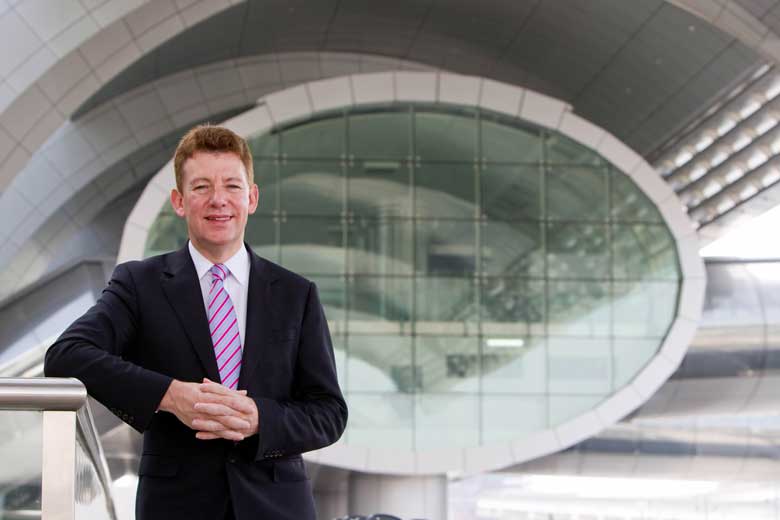

The traditional view of airport companies as infrastructure providers must change, says Dubai Airports CEO Paul Griffiths
At Dubai Airports, long-term thinking is an occupational necessity. Infrastructure development takes time and our strategic planning cycle starts with identifying requirements over a 10-15-year horizon. Our plans are based on projected growth, aircraft orders and evolving passenger needs and include detailed design, planning and execution.
As a result, while we are mindful of short-term fluctuations in regional and global traffic volumes due to socio-economic factors, we must also take a longer-term view of macro-economic factors and emerging trends that will shape our world 10 years or more from today.
And our world is changing. According to projections by the Organisation for Economic Co-operation & Development and the International Air Transport Association, in Asia alone there will be 1.93 billion additional passenger journeys by 2034, compared with 2014.
Accelerating urbanisation is supporting the importance of air travel, and in turn the concentration of population will shape travel patterns and reinforce the relevance of intercontinental hubs.
Airlines will continue to connect route networks to give people the from anywhere to anywhere service they demand. As a result, investment in the creation and expansion of the intercontinental hub will continue to play a vital role over the next two decades.
Dubai hub
In the case of Dubai, we add to that the emirates growth trajectory and emergence as a global centre for trade, commerce, tourism and finance in the decades ahead. These factors will similarly put demands on airport infrastructure as a fundamental enabler of that economic expansion.
Every customer that passes through an airport, whether departing, arriving or in transit, has needs that are unique
Accordingly, Dubai Airports and airport management companies the world over will need to invest sufficiently in cost-effective connection services to enable network efficiencies that cater for the increasingly mobile and growing middle class populations both in this region and, more specifically, in Asia.
But scale cannot be the sole focus. The traditional view of airport companies as infrastructure providers must change. We must become customer-centric. Every customer that passes through an airport, whether departing, arriving or in transit, has needs that are unique and most airports have yet to unlock the secrets of mass-customisation, which has been pioneered so well in manufacturing.
The answer is in our pockets: smartphones. The growth in portable computing power is only exceeded by the pace of miniaturisation. As technology has evolved and its usage skyrocketed, the world around us has changed. As have customer expectations.
This is heralding a new age of freedom from the linearity of scale and capacity. When you consider capacity equals space times flow, we can use technology to enhance flow through the same space. That is the fundamental premise underlying our DXB Plus programme, which is designed to improve service at space-constrained Dubai International, while boosting capacity to 118 million passengers by 2023 without adding any significant infrastructure.
It is also a driving consideration in the design and build of Dubai World Central, which will be the new home for Emirates airline in or around 2025, with an initial capacity for 120 million passengers, an ultimate capacity of 240 million and unparalleled customer convenience. By 2030, passenger numbers could surpass 200 million.
Rethinking technology
Since the first plane landed on the Creek some 80 years ago, Dubai has always taken a long-term view and adopted a visionary stance. Over the coming 20 years, we have a unique opportunity to take the next step in the evolution of the airport experience. To do this, we need to design and apply technology in a different way. We must change our thinking and our approach and put the customer first. That means collaboration and shared ownership across the customer experience sector.
Beyond that, the horizon will continue to shift. Alternative and renewable energies, emerging technologies, macro-economic forces and changing expectations and perspectives will shape aviation and mass transportation. We must continue to be vigilant in looking ahead. Always adapting. Always innovating. Ever focused on the needs of our customers.
As CEO of Dubai Airports, Paul Griffiths is responsible for the operation and development of Dubai International as well as Dubai World Central, which will eventually be the worlds biggest airport
You might also like...

Rainmaking in the world economy
19 April 2024

Oman receives Madha industrial city tender prices
19 April 2024

Neom seeks to raise funds in $1.3bn sukuk sale
19 April 2024

Saudi firm advances Neutral Zone real estate plans
19 April 2024
A MEED Subscription...
Subscribe or upgrade your current MEED.com package to support your strategic planning with the MENA region’s best source of business information. Proceed to our online shop below to find out more about the features in each package.








